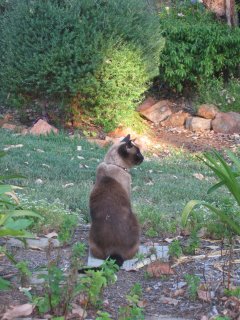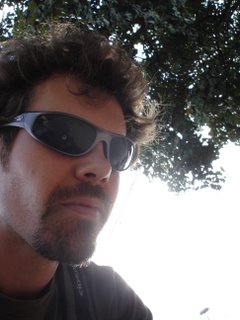Dateline: Tiruvannamalai. Having just finished a feast of fresh cooked parota, dosa and idly with chutney, I stepped out to the wet and muddy curbside of downtown Tiruvannamalai, accepted a steaming hot cup of chai from the wallah, and sighed in satisfaction.
The noise of the passing trucks, motor scooters, ox carts and buses could not touch me - they were all external factors that could not influence my internal contentment at the moment.
Looking around at the crowd of Indians and travelers from all corners of the world - this being a primarily Indian-patronized local eatery that is slowly being appropriated by tourists - I spied a set of bright eyes that held my attention and made me think twice.
Yes, its Pricilla!
Now I expect to meet friends in Bangkok. Exotic though it may be in itself, that is just something that happens whenever I arrive in old Siam. But in tiny Tiruvannamalai, in the shadow of mighty Mt Arunachalla and the embrace of Sri Bhagavan Ramana's spiritual legacy?!?!? Wow.
Spiritual EnergyAnd this mountain and this town is a place of incredible energy and focus. I am staying at a local ashram called Athiti, which is, for lack of a better term, "the real deal" - a place established for spiritual edification rather than profit, and expecting payment in the form of meditation time in addition to a cash donation of your choosing.
I spend a few hours a day meditating in the ashram hall, and the rest exploring the mountain and the other ashrams of the town. The other day I sat in contemplation for a few hours in a cave on the mountain where Sri Ramana lived and meditated for six years. It was a truly profound experience...
Contemplation
Meditation is something very new to me, and, like yoga, is something that is not yet a part of the fabric of my life. I hope that it will be eventually, and to that end I recently completed a Vipassana meditation retreat.
Vipassana meditation teaches the impermanence of all sensations and thoughts, in the process trying to free the mind of its dependence on external stimuli as its basis for happiness or misery. But I will not even try to paraphrase the philosophy of this ancient practice, so check out the homepage if you are interested:
www.dhamma.org.
10 Days of Noble SilenceThe retreat was, with no exception, the hardest thing I have ever done in my life, but not for the reasons I expected. It turns out that it is relatively easy to spend 10 days in noble silence, with no eye contact, no reading, no writing, no music or any other diversions. What is excruciating, however, is sitting for even just one hour without moving the body or even allowing the mind to wander.
The former I managed, if only for a few sessions - believe me, even if you reposition yourself 25 times to find the perfect, comfortable pose, you start to ache and pain after about 5 minutes and the body starts to scream in pain after about 30 more.
The latter is the bigger problem. The mind is exceedingly difficult to work with, especially if it has spent 33 years accustomed to being amused, distracted and otherwise entertained by whatever catches its fancy - TV, tunes, advertisements, people, clothing, cars, stereos, alcohol, food, etc. Even after 10 days of strict attention, I think I may be able to concentrate fully on 6 to 8 breathes in sequence if I am lucky...which is VERY frustrating.
Silver BulletThat being said, this was a very positive experience, and one I learned a lot from. But it was not a silver bullet that solved all of my problems - as I knew it would not and could not be, but nonetheless hoped it to be.
Did I "love" it?I don't think loving Vipassana meditation is possible until you have worked through a lot of physical and emotional pain. Goenka, the virtual teacher via recorded videos, keeps saying in the lectures that we are doing a "deep surgical operation," and I am very aware that I did not go so deep during this retreat - I am not being negative here, but am realizing that I went as deep as I was ready to / capable of going at the time.
What am I left with?
Well, the same thing I knew before in one way: That my mind is a mine field of distraction and aversion to self and environment, and that something has to be done to set my house in order.
I am also left with a new tool to attack this problem with, and the task of leveraging it instead of running away into the arms of the sensual world, which is very tempting (it even tempted me a lot during the course, with distractions often taking the form of sugar in various manifestations: brownies,
ice cream, crepes, etc.
However, I am not sure that I leave the course actually prepared or equipped to practice Vipassana meditation as a pure technique. I am practicing anapana sati (awareness of breathe) regularly since leaving the retreat, and hopefully this will prepare me to either: 1) begin introducing the full technique in my life; or 2) do another course and more firmly establish myself in the practice.


















